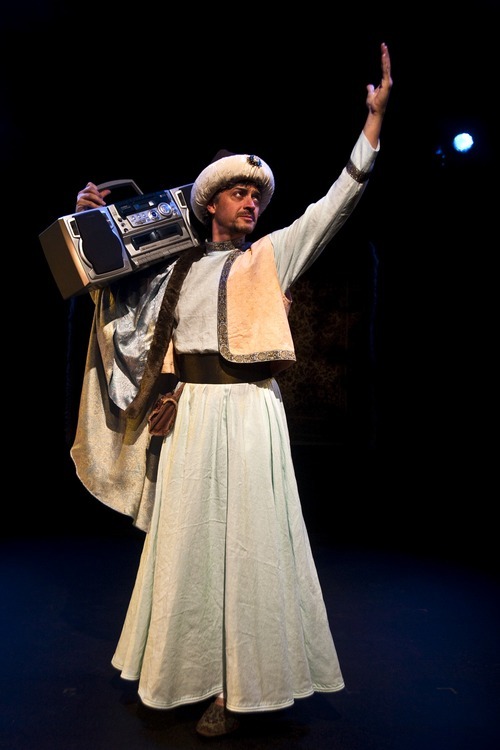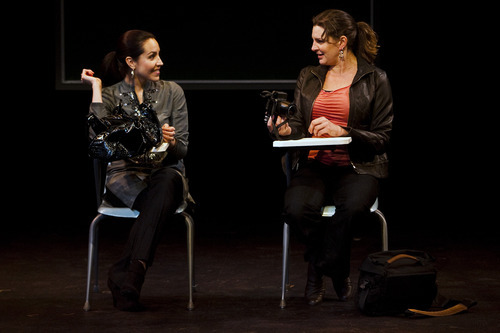This is an archived article that was published on sltrib.com in 2011, and information in the article may be outdated. It is provided only for personal research purposes and may not be reprinted.
Kathleen Cahill's play "The Persian Quarter" took more than a year to write, but it spans more than 30 years in the course of her life.
Under the light of history, that span stretches back even further, to the United States' 1953 coup of Iran's democratically elected prime minister in partnership with Great Britain, and even all the way back to 13th-century Persian poet Rumi.
"I happen to like poetry — a lot — and I happen to believe in it," said Cahill, a Salt Lake City transplant, during an interview at Salt Lake Acting Company with the play's cast. "It has the power to flow fresh air into your head."
Cahill's "The Persian Quarter" is set to begin its world-premiere run at SLAC on Feb. 4, and the show continues through Feb. 27.
Cahill is also a believer, of sorts, in signs.
The first thoughts behind her play percolated soon after June 2009 mass protests broke out in Iran in support of opposition candidate Mir-Hossein Mousavi. Watching thousands of young women clad in hijab head coverings and chadors clash with armed members of the government's Revolutionary Guard, Cahill thought back to the young women she taught English in the Iranian city of Shiraz more than 30 years ago.
The spirit of Rumi played a part too, whether coincidental or inspired. Browsing at the Anderson-Foothill branch of the Salt Lake City library, she spied a notice for an upcoming meeting of the Rumi Poetry Club. Then, during a trip to Venice, Calif., a large-scale wall graffiti declaring "Rumi Lives" jumped out at her.
"All plays are easy — and hard — to write," Cahill said. "I'm really happy I've had the opportunity to write about Iran. I think this play is going to mess with people's minds."
Audiences would be well within their rights to expect nothing less. "The Persian Quarter" melds Sufi-mystic poetry, the 1979 Iranian hostage crisis, a little-known case of U.S. foreign-policy meddling and the current state of Iranian politics, all played out over scenes set poolside and a New York City speaking engagement by Iranian President Mahmoud Ahmadinejad.
And yet, say Cahill and cast for of play, it isn't a history lesson or a polemic on current events.
Instead, says SLAC executive producer Keven Myhre, it's a drama with poetry as connective tissue, vaunting over scenes that lament possibilities people neglect or cannot see when politics and human passion get in the way. The arbiter is Rumi, played by Shane Mozaffari, a spiritual figure hovering over the play's events. Much like the poet's works, "The Persian Quarter" explores what bars people from higher, more beloved states of interaction.
After the playwright gathered her inspirations, all that remained was for her to write the play. Working with a cast of six main characters, Cahill wanted to craft a drama that would span a generation, as well as a pivotal event in the relation of two nations.
She settled on two mother-daughter pairs, with each pair played by the same actor. Deena Marie Manzanares plays revolutionary student Shirin, who keeps watch over American hostage Ann Gillies, as well as Azadeh, Shirin's daughter who is 30 years old after the Islamic Revolution of 1979. Nell Gwynn plays Ann Gillies, and also Emily Gillies, Ann's daughter, also 30 years old after the revolution.
"The Persian Quarter" opens with a poolside scene between Ann and her American boyfriend Mike, played by Josh Thoemke, progressing into contentious scenes between Shirin and Ann, then culminating in a scene between their daughters Azadeh and Emily.
That the play contains so many central women characters is no accident. More than other Middle East cultures, Cahill notes, women play a greater role in Iranian life.
Masoumeh Ebtekar became famous throughout the hostage crisis as the bullhorn-wielding spokeswoman for Iranian students who supported the 1979 Islamic revolution. Thirty years later, Iranian student Neda Agha-Soltan became the iconic image of the Green Revolution when millions watched riveting footage of her bleeding to death after being shot in the wake of a protest.
"There's something mystical, and completely unexpected about this play," said director Alexandra Harbold. —
'The Persian Quarter'
When • Feb. 4-Feb. 27; Wednesday-Saturday at 7:30 p.m., Sunday 2 and 7 p.m.
Where • Salt Lake Acting Company, 168 W. 500 North, Salt Lake City
Info • $15-$41; call 801-363-7522 to reserve, or visit http://www.saltlakeactingcompany.org.
More • SLAC will host a free panel discussion, "U.S.|Iran, Patriots|Poets, Pilou Rice|Apple Pie" Feb. 13 at 5 p.m., aimed at exploring the United States' relationship with Iran. Moderators include Rasoul Sorkhabi, director of Rumi Poetry Club, playwright Kathleen Cahill, co-founder of Equality Utah Jim Dabakis, and University of Utah political science professor Tim Chambless.









